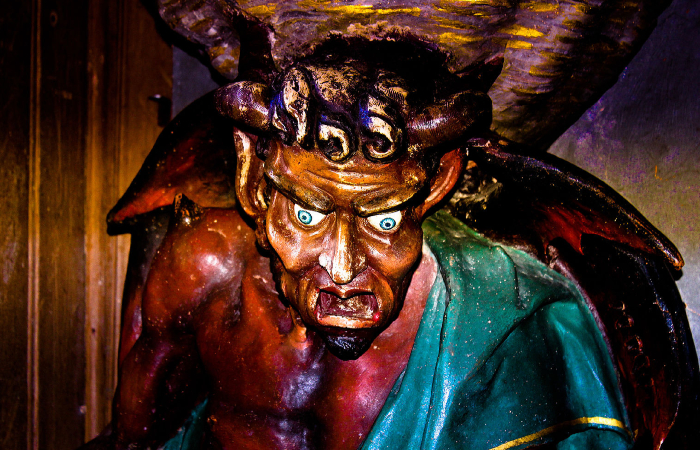Origins and etymology
The name Asmodeus is believed to derive from the Avestan term aēšma-daēva, where aēšma means «wrath» and daēva signifies «demon». In Zoroastrianism, Aēšma is the demon of wrath, and this concept likely influenced later Jewish demonology. In the Hebrew tradition, he appears as Ashmedai, and in Greek texts as Asmodaios. These variations reflect the demon’s integration into different cultures and languages over time.
Asmodeus in religious texts
The Book of Tobit
In the deuterocanonical Book of Tobit, Asmodeus is portrayed as a malevolent spirit who falls in love with Sarah, the daughter of Raguel. Out of jealousy, he kills seven of her successive husbands on their wedding nights before the marriages can be consummated. When Sarah becomes betrothed to Tobias, the angel Raphael instructs Tobias to burn the heart and liver of a fish, producing a smoke that drives Asmodeus away to Egypt, where Raphael binds him. This narrative positions Asmodeus as a demon of lust and destruction.
Talmudic literature
In the Talmud, Ashmedai is depicted with a more complex character. He is involved in various tales, including one where King Solomon captures him to assist in building the Temple in Jerusalem. In another story, Ashmedai overthrows Solomon, taking his place on the throne for a time before Solomon regains his position. These accounts present Ashmedai as both mischievous and powerful, capable of challenging even the wisest of kings.
The Testament of Solomon
The Testament of Solomon, a pseudepigraphical text, describes Asmodeus as a demon who opposes Solomon but is eventually subdued and compelled to aid in constructing the Temple. In this account, Asmodeus reveals that he is thwarted by the angel Raphael and by the smell of burning fish liver and heart, consistent with the narrative in the Book of Tobit. He also claims to be born of a human mother and an angel father, adding a layer of complexity to his origin.
Characteristics and attributes
Asmodeus is often associated with the sin of lust, one of the Seven Deadly Sins. In various demonological texts, he is described as having three heads—those of a man, a ram, and a bull—riding a dragon, and breathing fire. He is said to have a serpent’s tail and to emit flames from his mouth. These fearsome attributes underscore his role as a powerful and destructive demon.
In the Dictionnaire Infernal by Collin de Plancy, Asmodeus is depicted with the breast of a man, a cock leg, and a serpent’s tail, riding a lion with dragon wings. This imagery reinforces his association with lust and lechery.
Asmodeus in demonology
In the Ars Goetia, part of the Lesser Key of Solomon, Asmodeus (referred to as Asmoday) is listed as a powerful king of demons, commanding seventy-two legions of spirits. He is described as teaching arithmetic, astronomy, geometry, and all handicrafts. He also grants invisibility and leads people astray. His seal is used in various occult practices to summon him.
In the Malleus Maleficarum, a 15th-century treatise on witchcraft, Asmodeus is identified as the demon of lust, responsible for twisting people’s sexual desires. He is considered an adversary of Saint John the Baptist and is said to be strongest during the month of November.
Cultural depictions
Literature
Asmodeus has appeared in various literary works over the centuries. In Alain-René Lesage’s 1707 novel Le Diable boiteux (The Lame Devil), Asmodeus is portrayed as a witty and insightful demon who reveals the follies of mankind. This depiction influenced the English idiom «the devil on two sticks,» referring to someone who exposes hidden truths.
In John Milton’s Paradise Lost, Asmodeus is mentioned among the fallen angels. He also appears in François Mauriac’s play Asmodée, where he embodies temptation and moral conflict.
Visual arts
Artists have depicted Asmodeus in various forms, often emphasizing his monstrous features. In the 19th century, illustrations in demonological texts portrayed him with multiple heads and animalistic traits, reinforcing his fearsome nature. Statues and paintings have also depicted him as a limping devil, aligning with literary descriptions.
Modern media
In contemporary culture, Asmodeus appears in various forms of media. In the television series Supernatural, he is portrayed as a Prince of Hell, embodying charm and cruelty. In the anime Welcome to Demon School! Iruma-kun, a character named Asmodeus Alice serves as a powerful and loyal friend to the protagonist. Video games like Dungeons & Dragons feature Asmodeus as a major antagonist, ruling over the Nine Hells with cunning and power.
Symbolism and influence
Asmodeus symbolizes the destructive nature of uncontrolled desire and the consequences of succumbing to temptation. His stories often serve as cautionary tales about the perils of lust and the importance of virtue. His presence in various religious and cultural narratives underscores the universal struggle between moral integrity and base instincts.
In demonology, Asmodeus represents the dangers of indulgence and the importance of resisting temptation. His role as a tempter and destroyer serves as a reminder of the consequences of moral weakness.
Legacy
The figure of Asmodeus has endured through centuries, evolving from ancient demonology to modern pop culture. His multifaceted character—ranging from a fearsome demon to a cunning trickster—reflects humanity’s complex relationship with concepts of sin, temptation, and morality. Asmodeus continues to captivate the imagination, serving as a symbol of the eternal struggle between virtue and vice.
